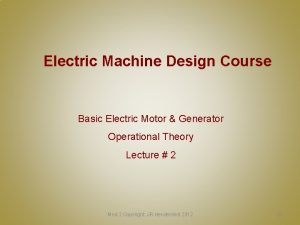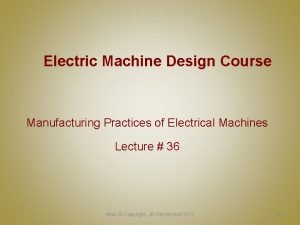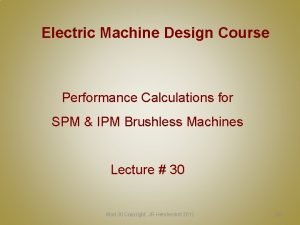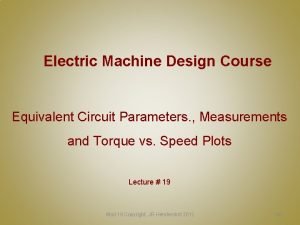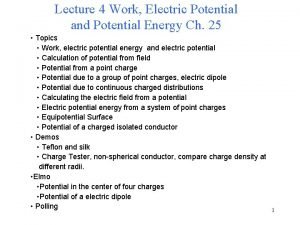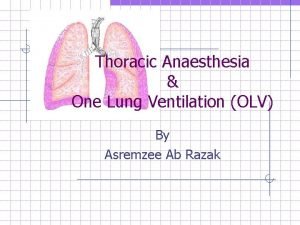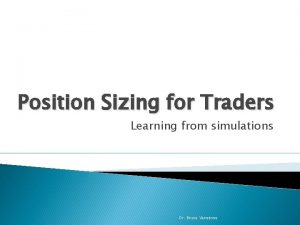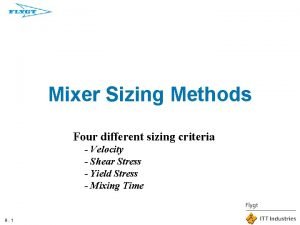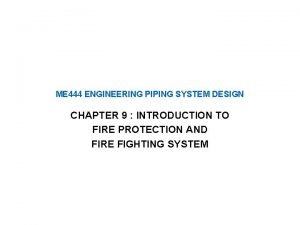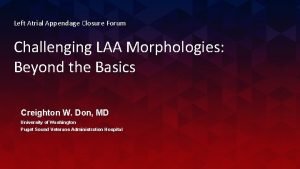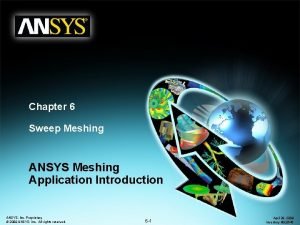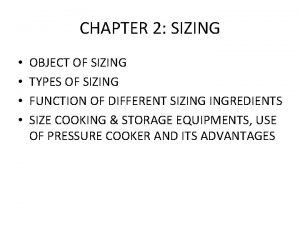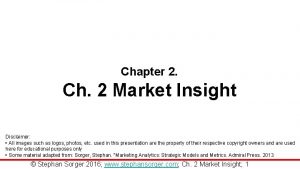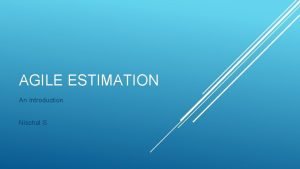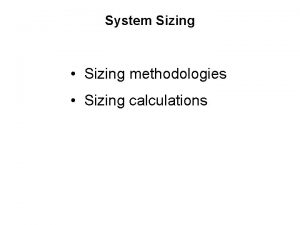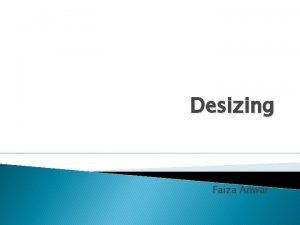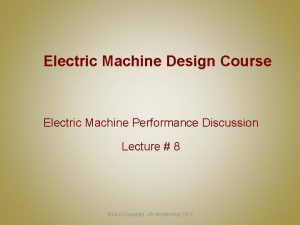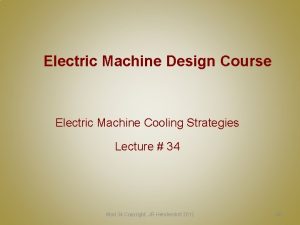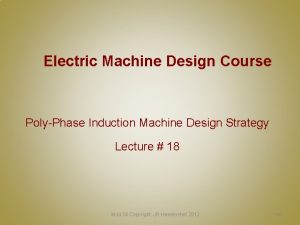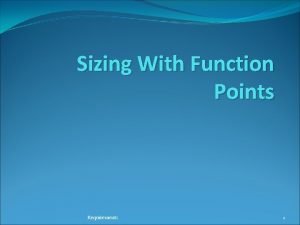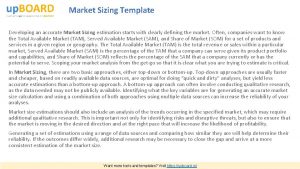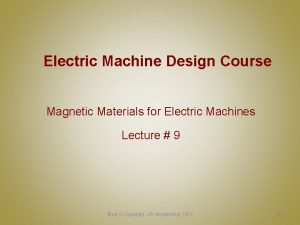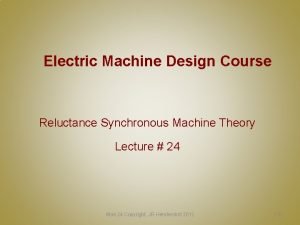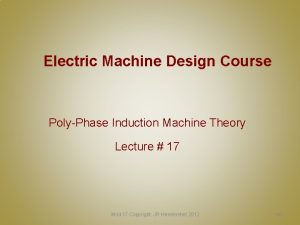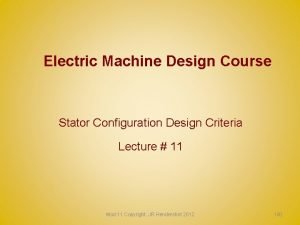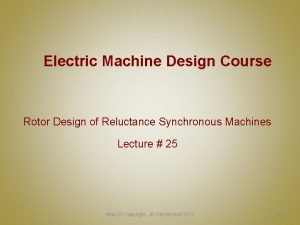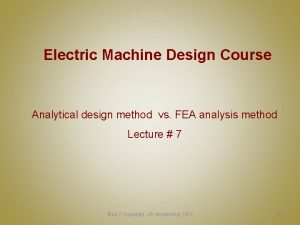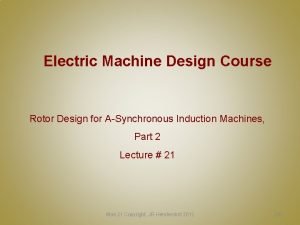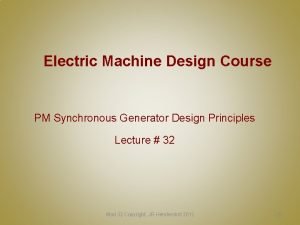Electric Machine Design Course Electric Machine Sizing Lecture




















- Slides: 20

Electric Machine Design Course Electric Machine Sizing Lecture # 5 Mod 5 Copyright: JR Hendershot 2012 50

Sizing of electrical machines using torque/rotor volume & gap stress Machines are primarily sized for rated torque capability (not power). Output torque is proportional to product of rotor volume & shear stress Air-gap shear stress is proportional to product of air-gap electrical & magnetic loading. Many IM & RSM machines are 4 pole so most of the rotor volume is magnetically active. Perhaps the best sizing parameter for IMs & RSMs is TRV Brushless or PMSM machines tend to have higher poles (8 or more) The best sizing parameter for PMSMs is probably air gaps stress. Mod 5 Copyright: JR Hendershot 2012 51

Rating considerations for electrical machines Dimensions of a machine depend on: Output torque at a specific speeds Air gap stress Air gap flux density Air gap current density Phase conductor current density Enclosure type, (TEFC, ODP, TEPV, TENC etc. ) Type of cooling (Natural, air over, forced air & liquid) The duty cycle of the load The frequency of starting and stopping Mod 5 Copyright: JR Hendershot 2012 52

Rotor to stator diameter vs. number poles once the stator OD is known Most all new design tasks of new machines begin with a known or given maximum stator core diameter. Start the design with an assumed rotor diameter based upon the number of poles from chart below. After machine sizing based upon the next few slides the core length is set for the final design analysis. Mod 5 Copyright: JR Hendershot 2012 53

Historical sizing method for electric machines TRV = Torque / Rotor Volume (active) TRV is related to air-gap shear stress B Ad = Air-Gap shear stress = Torque/gap radius/swept gap area Swept gap area = D l Mod 5 Copyright: JR Hendershot 2012 54

Suggested TRV & gap stress sizing guidelines 10 k. Pa = 1. 45 Psi Prof. TJE Miller Mod 5 Copyright: JR Hendershot 2012 55

Machine Electric Loading Current density in A/m, (Ad ) in the phase conductors is a measure of the current loading and determines either the machine duty cycle or the cooling requirements. The linear current density around the circumference of the air-gap between the rotor and stator can also be used to characterize the electric loading of the machine. Prof. TJE Miller Mod 5 Copyright: JR Hendershot 2012 56

Electric loading in air gap Gap-loading = Total amp-conductors/gap circumference n = number of phases, N = turns /phase I = rms Phase current, D = air-gap diameter Mod 5 Copyright: JR Hendershot 2012 57

Typical phase conductor current densities Mod 5 Copyright: JR Hendershot 2012 58

Magnetic air gap loading Magnetic air-gap loading analysis is sometimes used is machine sizing studies that is based upon the average flux density in the air gap. For example is is typical to try for air gap flux densities in the range of 0. 75 to 1. 0 Tesla. This is a desired starting place for the design of induction machine as well as RSM and PM rotors. To facilitate effective utilization of magnetic air gap loading for machine sizing, acceptable values must be available from measurements of existing machines that utilize similar methods of cooling with natural convection, forced air cooling or liquid cooling. Prof. TJE Miller Mod 5 Copyright: JR Hendershot 2012 59

Sizing of high speed machines Air gap stress guidelines and limitations on cooling must not be ignored For high speed rotors, the rotor retention for stable rotor dynamics is most important consideration Any movement of rotating components can cause unbalance leading to potential rotor failure or catastrophic contact with stator I. D. Start first with max allowable rotor “tip speed” (m/sec) and solve for air gap diameter (Dr) and length (Lr) to achieve desired air gap stress Tip Speed (m/sec) = (π/60) Dr (rpm) Tip speeds 75 m/sec for high strength non-magnetic alloy sleeves & 100 m/sec and higher for pre-stressed carbon fiber sleeves Mod 5 Copyright: JR Hendershot 2012 50

Additional suggestions for IM & RSM sizing If the specification places no limits on stator O. D. the TRV method for machine sizing can be used. The generally accepted practice for rotor D/L proportions has the rotor diameter at 0. 5 to 2 times the rotor core length. The continuous duty current density can be reduced by either increasing the core lengths or increasing the stator OD thereby providing for deeper stator slots for more winding space. If low inertial is a requirement then the D/L ratio determination must be optimized based upon the inertia related to the diameter squared and the length is directly proportional. Mod 5 Copyright: JR Hendershot 2012 51

Motor sizing the easy way or use as sanity check Well known fact that AC induction machines have rotor Ohmic losses which results in lower continuous ratings than SR, RSM or PMSMs (If this comment is arguable, assume all machines about the same) Several firms including ATE in Germany sell a complete line of rotor and stator elements fully tested and rated in two classes, S 1 & S 3 Cooling information such as liquid are provided as well ATE lists the dimensional details of these rotor and stators along with their speeds and output power ratings in both rating classes. Use of these published machine rating lists provides the electrical machine designer an excellent starting place for either a new design or as a sanity check to compare with his new design. Other motor vendors who publish similar performance data & dimensions for their motor elements are: Rueland (USA) and E und A (Switzerland) Mod 5 Copyright: JR Hendershot 2012 52

ATE motor element (4) Pole vs. KW data Mod 5 Copyright: JR Hendershot 2012 53

ATE motor element (6) Pole vs. KW data Mod 5 Copyright: JR Hendershot 2012 54

ATE motor element (8) Pole vs. KW data Mod 5 Copyright: JR Hendershot 2012 55

Title Mod 5 Copyright: JR Hendershot 2012 56

Title Mod 5 Copyright: JR Hendershot 2012 57

Title Mod 5 Copyright: JR Hendershot 2012 58

Title Mod 5 Copyright: JR Hendershot 2012 59
 Hendershot
Hendershot 01:640:244 lecture notes - lecture 15: plat, idah, farad
01:640:244 lecture notes - lecture 15: plat, idah, farad Electric machine design coaching
Electric machine design coaching Samantha cogging
Samantha cogging Electric machine design training
Electric machine design training Electric potential lecture
Electric potential lecture Electric potential lecture
Electric potential lecture Starbucks brand promise
Starbucks brand promise Double lumen tube sizing
Double lumen tube sizing Position sizing techniques
Position sizing techniques Mixer sizing calculations
Mixer sizing calculations Extinguishion
Extinguishion What is this
What is this Geothermal loop sizing
Geothermal loop sizing Evolut sizing chart
Evolut sizing chart Acurate neo sizing chart
Acurate neo sizing chart What is sweep method in ansys
What is sweep method in ansys Object of sizing
Object of sizing Market sizing examples
Market sizing examples Guesstimate market sizing
Guesstimate market sizing T-shirt sizing chart agile
T-shirt sizing chart agile
